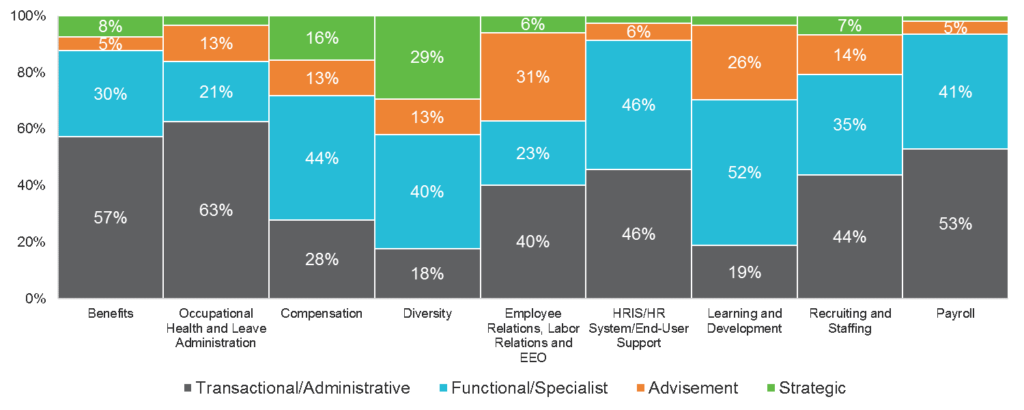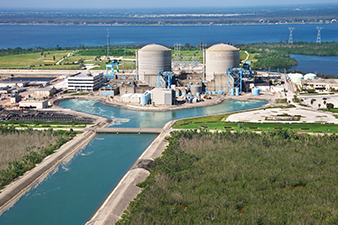
In order to transform the organization, one must first understand it. Many companies today are aggressively trying to transform their organization, seeking to improve organizational performance by changing behavior and capabilities, consolidating transactional activities into a shared services model, or trying to reallocate resources across units. An important first step for understanding the current issues or the impact of any changes is to understand who does what in the organization. By starting with a thorough assessment of where you stand today, you can identify the greatest opportunities for efficiency gain and deploy resources accordingly.
 Conducting a work activity assessment enables you to take a standardized, uniform approach to measure the type and amount of work being performed across functions and processes. In addition, a work activity assessment produces a clear picture of the labor costs associated with a function’s services and processes. Collecting data from individual employees at the activity level provides a detailed snapshot of where, how much, by whom, and at what cost work activities in assessed functions are performed across your organization. You can then draw powerful insights on how your organization, service delivery model, or staffing structure can be optimized, leveraging data from the assessment.
Conducting a work activity assessment enables you to take a standardized, uniform approach to measure the type and amount of work being performed across functions and processes. In addition, a work activity assessment produces a clear picture of the labor costs associated with a function’s services and processes. Collecting data from individual employees at the activity level provides a detailed snapshot of where, how much, by whom, and at what cost work activities in assessed functions are performed across your organization. You can then draw powerful insights on how your organization, service delivery model, or staffing structure can be optimized, leveraging data from the assessment.
Why Assess Work Activities?
A thorough work activity assessment can deliver many benefits. First, it is a great opportunity to document the work being performed to understand current staffing levels and labor costs of functions and processes. The results of a work activity assessment provide a comprehensive picture of work distribution and cost by location, by role, and individual. Process costs and staffing levels can then be compared against benchmarks and leading practices to evaluate current performance. The analysis will quantify administrative or transactional work that should be reduced in a new delivery model with process improvements, increased automation, and better role alignment.
Second, collecting data directly from individual employees helps to identify specific persons involved in each process or activity. If you decide to make changes to processes, the work activity data will indicate from which employees work should be transitioned.
Third, the assessment will establish a baseline from which you can compare future work allocations to the original organization. This baseline supplies quantitative data for building a business case to support the changes and allows you to compare data after you make changes. This comparison can be used to demonstrate efficiency and cost improvements as a result of the organization’s changes.
How Do You Do It?
The typical process for conducting a work activity assessment involves the following six major steps. Customizing the assessment process to fit your organization’s unique situation and information requirements where needed is also recommended.
Figure 1: Recommended Work Activity Assessment Process

Here are a few key factors to consider that have proved valuable in practice:
- Look broadly when identifying applicable employees to participate. Employees outside of designated functions may also be performing work that relates to the assessment
- Send advanced notifications to explain the survey purpose to reduce employee anxiety
- Gain leadership buy-in, which will help increase participation levels
- Make sure functional SMEs are consulted and sign off on the survey content
- Define activities in terms that can be recognized by your employees
- Consider having some “office hours” or information sessions where people can walk through the survey with a moderator
- Provide on-going support while the survey is in deployment to answer questions and resolve any technical issues
- Consider sending reminder emails from the leadership team, which can be helpful to get stragglers to complete the survey
- Identify any data anomalies and address those by following up directly with respondents
- Consider asking questions like these when analyzing your work activity assessment data:
- To which activities does your team currently allocate the largest amount of time? Are those aligned with what you would expect? How much do these activities cost to deliver?
- What is the overall nature of the work being performed? How does your work type allocation align with leading practices?
What Do We See?
ScottMadden conducts web-based work activity assessments for our clients across various industries and functional areas. Below are results from the analysis of HR and Finance & Accounting (F&A) data to illustrate some example outcomes.
The optimal activity allocation is unique for each organization, considering the size and maturity of the organization, customer geographies served, service delivery model, alignment with overall organization and business goals, and many other factors. Work activity analysis provides visibility into how your current organization’s work is aligned against an optimal state. When examining the distribution of work prior to moving to a leading practice service delivery model, we find that the top four HR sub-functions account for 65% of the total FTEs, led by recruiting and staffing, learning and development, employee relations/labor relations/EEO, and benefits. Similarly, F&A FTEs are also relatively concentrated in the top sub-functional areas of general accounting and reporting, accounts receivable/billing and collection, accounts payable and expense reimbursements, and planning and management accounting. Those activities make up nearly three-quarters of total F&A FTEs before transitioning to a leading practice model.
Figure 2: Typical FTE Distribution across Major Sub-Functions for HR and F&A

The amount of administrative work across sub-functions is an important indicator of improvement potential in effectiveness and labor-related cost savings. Our data indicate that the top sub-functional areas in HR that deliver the most transactional work are occupational health/leave administration, benefits, payroll, and HRIS/HR system/end-user support.
Figure 3: Typical FTE Distribution by Work Type and Major HR Sub-Function

We expect that executive or senior leadership positions have a larger percentage of strategic or advisory work than non-leadership positions. As it turns out, typical transactional and functional percentages for managers and supervisors and senior leadership positions indeed represent opportunities. In an F&A organization without shared services, transactional and administrative activities typically consume 25% of manager/supervisor time and 16% of executive/director time. In an HR organization without shared services, those percentages are even higher.
Figure 4: Typical FTE Distribution by Work Type and Position for HR and F&A

Conclusion
A work activity assessment is one piece of the puzzle in understanding the current state of an organization’s work allocation and costs associated with key processes. Other benefits of the approach include identifying all process participants to enable transition planning and establishing a baseline from which future changes can be compared. The analysis often yields surprising results that are important inputs to any change in organization or delivery model. Work activity survey data are even more powerful when they enrich the qualitative and quantitative data obtained from complementary assessment activities, such as stakeholder interviews, benchmarking, leading practice analysis, and span and layer assessment.
How ScottMadden Can Help
To learn more about how ScottMadden can help you with a work activity assessment to support your transformation, please contact us.
Additional Contributing Author: Min Qin

















































